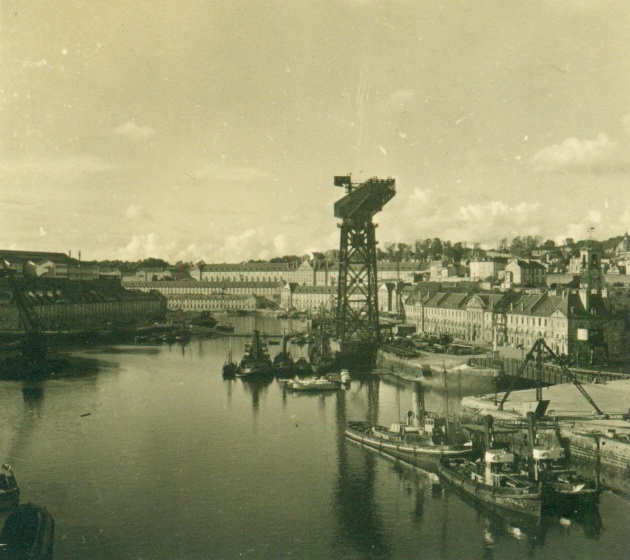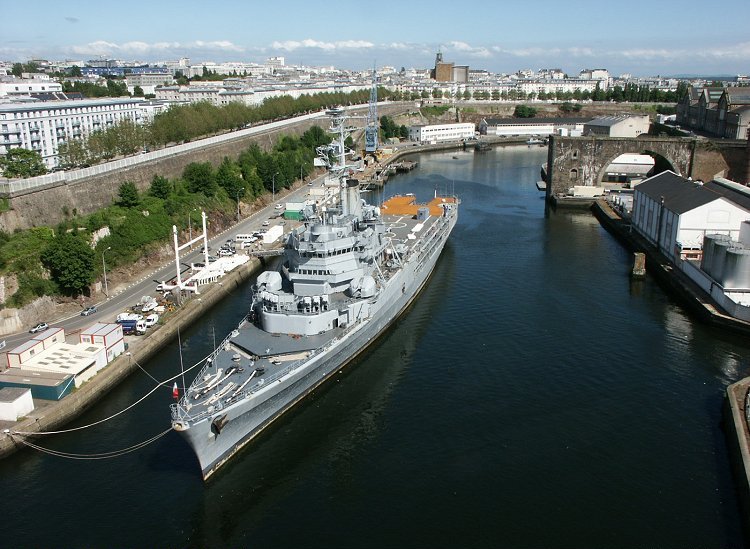Brest Arsenal on:
[Wikipedia]
[Google]
[Amazon]
 The Brest Arsenal () is a collection of naval and military buildings located on the banks of the river Penfeld, in
The Brest Arsenal () is a collection of naval and military buildings located on the banks of the river Penfeld, in
 1940 – Construction of the Submarine Base during the German occupation - the military port became an important German strategic base.
*1963–1964 – Jetty enlarged.
*1969–1970 – Construction of aircraft-carrier locks 3 and 4.
1940 – Construction of the Submarine Base during the German occupation - the military port became an important German strategic base.
*1963–1964 – Jetty enlarged.
*1969–1970 – Construction of aircraft-carrier locks 3 and 4.

High command of the Brest maritime arrondissement
French Navy site
Arsenal de Brest, France
Military history of Brest, France Buildings and structures in Brest, France Brest Brest Arsenals Former submarine builders
 The Brest Arsenal () is a collection of naval and military buildings located on the banks of the river Penfeld, in
The Brest Arsenal () is a collection of naval and military buildings located on the banks of the river Penfeld, in Brest, France
Brest (; ) is a port, port city in the Finistère department, Brittany (administrative region), Brittany. Located in a sheltered bay not far from the western tip of a peninsula and the western extremity of metropolitan France, Brest is an impor ...
.
Timeline
*1631–1635 – Beginning of the foundations of the port infrastructure. *1674 – Appearance of the Powder Magazines, Cordellerie and Military Hospital. *1683 – Creation of the Troulan dock. *1746 – Creation of the three Pontaniou docks near the anchor forges and naval constructions. *1752 – Construction of the Bagne demolished in 1947. *1807 – Construction of the Bâtiment aux Lions to house the arsenal's magazines. *1822–1827 – Construction of Bassin 6 at the Salou. *1858 – Appropriation of the Tourville and Jean Bart quays by the navy. *1864–1865 – Construction of Bassin 7 at the Salou. *1865 – Closure of the Penfeld port to commercial boats, turning it into a military port. *1889–1896 – Construction of the South Jetty (1,500 m). *1895–1900 – Construction of the West Jetty (200 m). *1899–1902 – Transformation of the four Pontaniou docks into 2 large basins, now known as Basin 2 and Basin 3. *1900–1905 – South Jetty extended by 750 m. *1905 – Construction of the Quai d'Armement. *1910 – Installation of the Grande Grue. *1910–1916 – Digging of the two construction docks and of the Laninon dry dock, now known as Basin 8 and Basin 9. *1911 – Infilling of the terreplein of Brest Castle. *1918 – Construction of the Quai des Flottilles. *1931–1933 – Closure of the western passage. *1938 – Work begun on the construction of Bassin 10 de Laninon (work abandoned 1939–1945). * 1940 – Construction of the Submarine Base during the German occupation - the military port became an important German strategic base.
*1963–1964 – Jetty enlarged.
*1969–1970 – Construction of aircraft-carrier locks 3 and 4.
1940 – Construction of the Submarine Base during the German occupation - the military port became an important German strategic base.
*1963–1964 – Jetty enlarged.
*1969–1970 – Construction of aircraft-carrier locks 3 and 4.

Penfeld quays
The Penfeld, within the military enclosure, is almost wholly lined with quays, but ships cannot come directly alongside these quays because of heads of rock that are left exposed at low tide. That's why floating stages are moored fore and aft, mainly on the left bank, to make up ''postes'' where some “small” ships can come alongside and use some installations such as the large crane. Little used upstream of the Pont de Recouvrance, downstream of this bridge these ''postes'' nevertheless serve the old sailing ships of the Navy, the tugboats and other support boats of the arsenal, and ''transrades'',passenger ship
A passenger ship is a merchant ship whose primary function is to carry passengers on the sea. The category does not include cargo vessels which have accommodations for limited numbers of passengers, such as the ubiquitous twelve-passenger freig ...
s which provide a service across the roadstead
A roadstead or road is a sheltered body of water where ships can lie reasonably safely at anchor without dragging or snatching.United States Army technical manual, TM 5-360. Port Construction and Rehabilitation'. Washington: United States. Gove ...
(''rade de Brest'') between Brest and the Crozon peninsula ( Île Longue, École Navale
École or Ecole may refer to:
* an elementary school in the French educational stages normally followed by secondary education establishments (collège and lycée)
* École (river), a tributary of the Seine flowing in région Île-de-France
* Éco ...
)
References
{{reflist, refs= {{cite web , title=Arsenal de Brest , url=https://www.naval-technology.com/projects/arsenaldebrest/?cf-view&cf-closed , website=Naval Technology , access-date=8 February 2024See also
* ĂŽle Longue * Pont de Recouvrance * Recouvrance * Penfeld * Rue Saint-MaloExternal links
High command of the Brest maritime arrondissement
French Navy site
Arsenal de Brest, France
Military history of Brest, France Buildings and structures in Brest, France Brest Brest Arsenals Former submarine builders